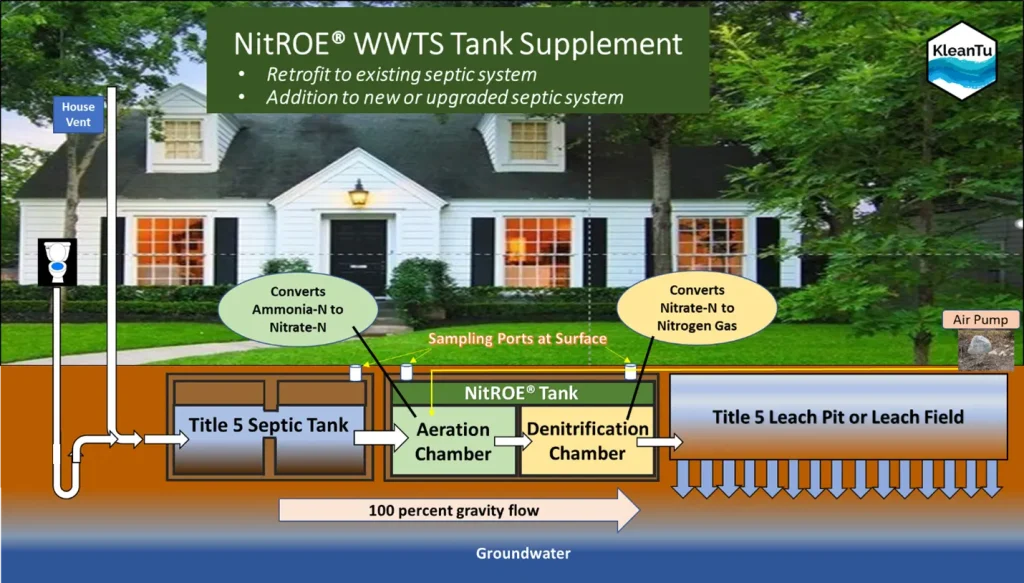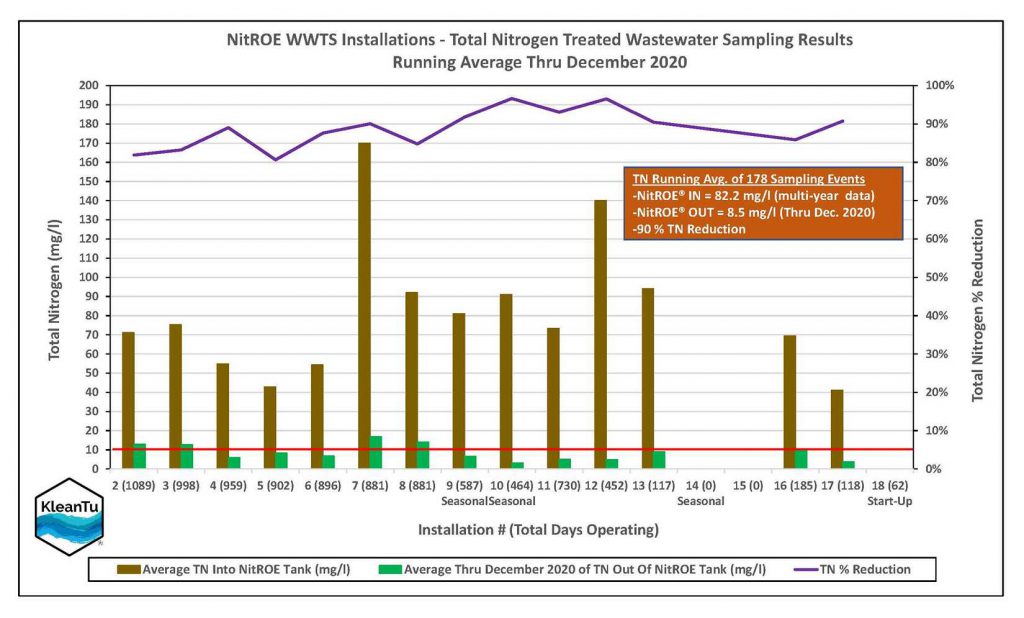NitROE® Waste-Water Treatment System (WWTS)
KleanTu® developed the NitROE® Waste-Water Treatment System (WWTS) to supplement new or existing septic systems and treat the discharge to a level that is comparable to discharge from a municipal wastewater treatment plant.
Unlike a conventional septic system, a NitROE® WWTS significantly reduces nitrogen compounds (and phosphorus, if required). A primary application for nitrogen removal is in locations where total nitrogen compounds in septic tank discharges are excessive, causing negative environmental impacts. Based on the currently active installations, NitROE® WWTS have been shown to consistently achieve average nitrogen levels below 10 mg/L, after the initial startup period. In addition to being discharged into a leach field or pit, the discharge from the NitROE® WWTS with disinfection may also be discharged to a surface water body, depending on the particular state regulations, or it can be beneficially reused for non-potable purposes, such as non-food crop [or lawn] irrigation.

The KleanTu NitROE® WWTS consists of a conventional septic tank (may be existing septic) and one or more NitROE® treatment tanks based on the daily volume of wastewater being treated. The NitROE® tank (or multiple tanks) is the same size and construction as a conventional septic tank, but it contains the treatment components to remove organic matter and nitrogen. The WWTS can be designed for single-family up to multiple unit residential or commercial properties with design flows of 200 to 2,000,000 gallons per day (GPD).
Gravity moves wastewater through the tanks so that the only piece of mechanical equipment is an air pump, which quietly operates from beneath a faux rock. The KleanTu® NitROE® upgrades conventional septic systems so that there is always a minimum of septic system treatment even in a power outage.
Installation for smaller units can be done within days, with little disruption to the homeowner, and the final area can be landscaped with no obtrusive parts, no odor and minimal noise. For new construction, KleanTu® can work with your contractors to perform the installation according to the project schedule.

Reliable Nutrient Reduction
KleanTu® has been operating NitROE® systems in Massachusetts since early 2017. These systems have consistently shown 90% reduction or greater in total nitrogen after the initial startup period. The graph below illustrates the total average nitrogen in and out of each of the active NitROE® installations in December 2020. KleanTu® continues to optimize treatment to obtain even lower nitrogen concentrations, taking into consideration variations in nitrogen influent concentrations, cold weather/water temperature and seasonal use that may affect the efficiency of removal. The system can also include treatment of phosphorus or disinfecting, if needed.

SanTOE® Waste-Water Treatment System (WWTS)
The SanTOE® WWTS achieves advanced treatment of sanitary wastewater through a series of low-energy, natural process-based stages designed to remove a number of organic and inorganic contaminants via a combination of physical, chemical and biological mechanisms. These are the same mechanisms operating within various tank-based wastewater treatment systems, but configured in a more efficient manner, enabling lower capital and lower operational expenditures. The system is flexible in design and operation, such that it can be used for treatment of wastewater flow rates ranging from 700 to 2,000,000 gallons per day (gpd). Thus, it can be used to cost-effectively treat wastewaters from housing developments, apartment or condominium complexes, retail facilities and small communities.

The SanTOE® WWTS is similar to the NitROE® WWTS in that it is installed underground in tank-based systems. With the SanTOE® WWTS designed to enable low operations & maintenance by maximizing gravity flow, and having minimal mechanical equipment, there are less routine maintenance activities to be done, or equipment to be maintained or replaced. For this reason, the maintenance effort for a SanTOE® WWTS does not proportionally increase with increasing wastewater flowrate and corresponding size of the treatment system. Because of the simplicity of the operations and with convenient remote-sensing technologies, the need for a full-time on-site operator is eliminated.

Why KleanTu’s NitROE® and SanTOE®?
The KleanTu® NitROE® and SanTOE® WWTSs are self-contained, unobtrusive, domestic wastewater treatment systems that meet the same requirements for discharge that a centralized wastewater treatment plant meets. Additionally, the system requires minimal electricity requirement and only a small amount of maintenance over time.
KleanTu® Wastewater Treatment System Advantages
KleanTu®’s WWTS use minimal resources once installed, are adaptable to different flow rates (up to thousands of gallons per day) and discharge requirements, reduce risk of system-wide failure since it is managed at the individual level and can be set up with remote sensing to monitor conditions, and allow for incremental development and investment.
Monitoring, Operation & Maintenance (MOM)SM System
Monitoring, Operation & Maintenance (MOM)SM is essential to address the historical concerns of regulatory and health agencies that on-site systems do not receive satisfactory care. Monitoring, Operation & Maintenance (MOM)SM consists of remote monitoring with notifications, scheduled routine inspection and sampling, a database tracking activities and monitoring results, standby troubleshooters to address any potential issues, and other features to support ease of operation. Hence, the Monitoring, Operation & Maintenance (MOM)SM System provides the services missing from virtually all other competitors so that environmental and health agency concerns can be alleviated and the homeowner can Flush & ForgetSM.
KleanTu®‘s Sustainable Approach
Additionally, KleanTu® uses a sustainable approach to wastewater treatment, by utilizing local contractors and recycled materials for construction, whenever possible, and increasing wastewater reuse opportunities.

